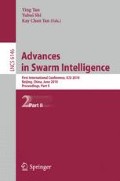Abstract
Fuzzy cluster validity criterion tends to evaluate the quality of fuzzy partitions produced by fuzzy clustering algorithms. In this paper, an effective validity index for network fuzzy clustering is proposed, which involves the compactness and separation measures for each cluster. The simulated annealing strategy is used to minimize this validity index, associating with a dissimilarity-index-based fuzzy c-means iterative procedure, under the framework of a random walker Markovian dynamics on the network. The proposed algorithm (SADIF) can efficiently identify the probabilities of each node belonging to different clusters during the cooling process. An appropriate number of clusters can be automatically determined without any prior knowledge about the network structure. The computational results on several artificial and real-world networks confirm the capability of the algorithm.
Access this chapter
Tax calculation will be finalised at checkout
Purchases are for personal use only
Preview
Unable to display preview. Download preview PDF.
References
Albert, R., Barabási, A.L.: Statistical Mechanics of Complex Networks. Rev. Mod. Phys. 74(1), 47–97 (2002)
Newman, M.: The Structure and Function of Networks. Comput. Phys. Commun. 147(1), 40–45 (2002)
Newman, M., Barabási, A.L., Watts, D.J.: The Structure and Dynamics of Networks. Princeton University Press, Princeton (2005)
Barabási, A., Jeong, H., Neda, Z., Ravasz, E., Schubert, A., Vicsek, T.: Evolution of the Social Network of Scientific Collaborations. Physica A 311, 590–614 (2002)
Ravasz, E., Somera, A., Mongru, D., Oltvai, Z., Barabási, A.: Hierarchical Organization of Modularity in Metabolic Networks. Science 297(5586), 1551–1555 (2002)
Girvan, M., Newman, M.: Community Structure in Social and Biological Networks. Proc. Natl. Acad. Sci. USA 99(12), 7821–7826 (2002)
Newman, M., Girvan, M.: Finding and Evaluating Community Structure in Networks. Phys. Rev. E 69(2), 026113 (2004)
Newman, M.: Modularity and Community Structure in Networks. Proc. Natl. Acad. Sci. USA 103(23), 8577–8582 (2006)
Zhou, H.: Distance, Dissimilarity Index and Network Community Structure. Phys. Rev. E 67(6), 061901 (2003)
Weinan, E., Li, T., Vanden-Eijnden, E.: Optimal Partition and Effective Dynamics of Complex Networks. Proc. Natl. Acad. Sci. USA 105(23), 7907–7912 (2008)
Li, T., Liu, J., Weinan, E.: Probabilistic Framework for Network Partition. Phys. Rev. E 80, 26106 (2009)
Shi, J., Malik, J.: Normalized Cuts and Image Segmentation. IEEE Trans. Pattern Anal. Mach. Intel. 22(8), 888–905 (2000)
Meilǎ, M., Shi, J.: A Random Walks View of Spectral Segmentation. In: Proceedings of the Eighth International Workshop on Artificial Intelligence and Statistics, pp. 92–97 (2001)
Lovasz, L.: Random Walks on Graphs: A Survey. Combinatorics, Paul Erdos is Eighty 2, 1–46 (1993)
Xie, X.L., Beni, G.: A Validity Measure for Fuzzy Clustering. IEEE Tran. Pattern Anal. Mach. Intel. 13(8), 841–847 (1991)
Hastie, T., Tibshirani, R., Friedman, J.: The Elements of Statistical Learning: Data Mining, Inference and Prediction. Springer, New York (2001)
Metropolis, N., Rosenbluth, A.W., Rosenbluth, M.N., Teller, A.H., Teller, E.: Equation of State Calculations by Fast Computing Machines. J. Chem. Phys. 21(6), 1087 (1953)
Kirkpatrick, S., Gelatt, C.D., Vecchi, M.P.: Optimization by Simulated Annealing. Science 220(4598), 671–680 (1983)
Zachary, W.: An Information Flow Model for Conflict and Fission in Small Groups. J. Anthrop. Res. 33(4), 452–473 (1977)
Penrose, M.: Random Geometric Graphs. Oxford University Press, Oxford (2003)
Author information
Authors and Affiliations
Editor information
Editors and Affiliations
Rights and permissions
Copyright information
© 2010 Springer-Verlag Berlin Heidelberg
About this paper
Cite this paper
Liu, J. (2010). Finding and Evaluating Fuzzy Clusters in Networks. In: Tan, Y., Shi, Y., Tan, K.C. (eds) Advances in Swarm Intelligence. ICSI 2010. Lecture Notes in Computer Science, vol 6146. Springer, Berlin, Heidelberg. https://doi.org/10.1007/978-3-642-13498-2_3
Download citation
DOI: https://doi.org/10.1007/978-3-642-13498-2_3
Publisher Name: Springer, Berlin, Heidelberg
Print ISBN: 978-3-642-13497-5
Online ISBN: 978-3-642-13498-2
eBook Packages: Computer ScienceComputer Science (R0)

